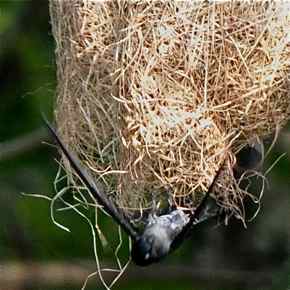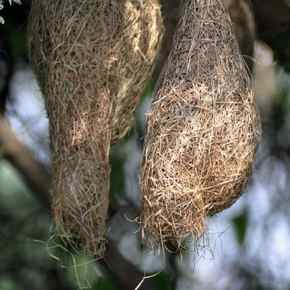“I was out today to re-visit old locations in the city, with secondary jungle/scrub, that are being threatened by development.
“In May 2009 I reported a Baya Weaver (Ploceus philippinus infortunatus) nesting colony (8-10 nests) where Glossy Swiftlets (Collocalia esculenta cyanoptila) were robbing the active nests of Baya Weaver of their nesting material
“Went back to the exact location and saw the same behaviour still occurring.
“Many Glossy Swiftlets, one or two at a time would swoop down repeatedly to the completed Baya Weaver nest. They all target the same two nests that were already partially destroyed (one more than the other, both were close to each other). The material was again collected from the nest entry location (entrance-tube section). Possibly easier to steal and rip off from this location.
“The Glossy Swiftlets would either swoop in and grab a loose strand with their beak and pull away until it snapped. Or land upside down, hold on with their feet and pull out a strand (above left).
“Again they were stealing the Baya Weaver nesting material from a nest with young within. The activity was ‘violent’ and the nest swing side to side as they pulled strands hard. Again the Baya Weavers continued to feed their young (some difficulty in entering the nest) but did not seem to chase away the Glossy Swiftlets (above right). All the material brought for feeding was animal prey and I have only seen female feeding young (often caterpillars).
“About 10 meters away I saw more ‘healthy’ Glossy Swiftlets that were collecting nesting material of dried strands from a dead creeper (above left) It was tougher work but an honest day’s labour.
“You can see in contrasting the two nest being robbed how much material has been lost from the entrance-tube section of the nest (above right).
“I suspect this “colony” of Glossy Swiftlets has learned this bad behaviour and it will persist.”
Dato’ Dr Amar-Singh HSS
Ipoh City, Perak, Malaysia
6th March 2010













One Response